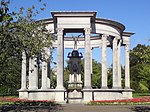Cathays railway station

Cathays railway station is a station on the Merthyr and Rhondda lines in the Cathays district of Cardiff, Wales. It is 1+1⁄4 miles (2 km) north of Cardiff Central. The station is next to Cardiff University Students' Union and across the road from many Cardiff University buildings, as well as a short walk from the Welsh Government and other civic buildings in Cathays Park. The footbridge over the railway is much used as a shortcut between Park Place and Senghenydd Road. When Cathays opened in 1983 it reversed a trend to close stations. Funded by British Rail and South Glamorgan County Council, construction commenced in April 1983, with the station opened on 3 October 1983.Cathays station is now manned in peak hours, since the introduction of a new automated ticket barrier system in summer 2007. Cathays has two platforms, each with a small shelter and an information screen displaying the next train's arrival.
Excerpt from the Wikipedia article Cathays railway station (License: CC BY-SA 3.0, Authors, Images).Cathays railway station
Cardiff Cycleway 1, Cardiff Castle
Geographical coordinates (GPS) Address Nearby Places Show on map
Geographical coordinates (GPS)
| Latitude | Longitude |
|---|---|
| N 51.4891 ° | E -3.1793 ° |
Address
Northbound platform
Cardiff Cycleway 1
CF10 3QN Cardiff, Castle
Wales, United Kingdom
Open on Google Maps










